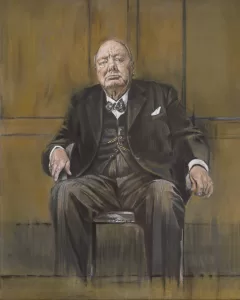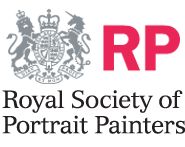
Graham Sutherland, ‘William Churchill’
WINNING ESSAY:
The State and the Art
“When I do stare, see how the subject quakes.”
King Lear Act IV Scene 6
This year marks the centenary of James Guthrie embarking upon the commission that would occupy much of his final decade, his austere and magisterial citation of the British Imperial leadership during the Great War, ‘Statesmen of World War I’ (1924-30).
Guthrie’s immense portrait draws one’s gaze towards a wan, furrowed-browed Winston Churchill, bathed in neo-classical sunlight, one of three seated figures – alongside Asquith and Lloyd George – offering direct eye contact beneath Niké’s own absent gaze. One might imagine him brooding over his disastrous gambit at Gallipoli, or the trauma of his time at the Front.
Meanwhile, our most recent political portrait of renown is comedian Joe Lycett’s ‘Fucking Hell’ (2023), a bust of fifty-sixth Prime Minister Liz Truss, offering-up a xanthic pseudo-eikon: an ironised miniature to carry around on one’s mobile-phone in scornful remembrance, its eponymous legend blazoned in turquoise for maximum visual attack.
Whilst some may ascribe Lycett’s portrait to Shrigleyesque giftshop-pranksterism or a social-media brand-management exercise, he nonetheless joins Cold War Steve (a viral Peter Kennard-lite) as a glib, satirical release valve for a disenfranchised populace. With state-commissioned ministerial portraits having all but disappeared, what then might these hyper-Hogarthian squalls tell us about the future of British state portraiture, and just how the fucking hell did we get here?
It should be noted that Churchill was not always flattered by his painted likeness. If Guthrie captured him in the ascendancy, 1954 saw Graham Sutherland accept the unenviable task of realising Parliament’s gift to Churchill on the occasion of his 80th birthday. Sutherland’s mid-career shift into portraiture, via the louche Mediterraneanism of his portrait of Somerset Maugham, proved scant preparation for the subject at hand.
Cajoled into working in Churchill’s own studio, Sutherland encountered a labile fellow artist at turns sabre-sharp and drowsing drunk, in recovery from stroke yet fending off his equally ailing successor – as conscious of his legacy as any before or since.
Nonetheless, Sutherland’s portrait is masterful in capturing Churchill’s aristocratic deportment, most especially in his treatment of the hands. Recalling Piero della Francesca’s emergent, resurrected Christ grasping at his robes, Churchill’s hands bear witness to a (states)man in hesitant transition.
Although conservative by the standards of his modernist contemporaries, Sutherland’s restrained provisionalism – his subject dissolving from the ankles up in a crib from his frenemy Bacon, canvas showing through to preserve ‘freshness and bite’ – proved too much for Churchill. The painting was thrice denied. First by letter, then in public – Winston, head tossed-back, recalling Daumier’s sceptical patron from ‘The Public at the Exhibition’, scorning its modernity – and finally by fire, his private secretary discreetly immolating it in her brother’s garden.
The challenge of immortalising an elder statesperson was surely as keenly felt by Bryan Organ when Harold Macmillan sat for him in 1980, six years prior to the latter’s death. Indeed ‘80 marked something of a triumphant period for Organ, whose spare, withholding style also gave us perhaps the finest modern royal portrait in ‘Prince Charles’ (1980) this same year.
The painter’s habit of situating his subjects inside their own portraits was fit staging for Macmillan, who himself had weathered criticism for having been packaged and sold ‘like washing powder’ during Britain’s first televised election two decades prior. And, indeed, with Organ’s gridded, paint-by-numbers fidelity – the very antithesis of sfumato – what one sees is what one gets.
In Macmillan’s case, this was vulnerability – a favoured ruse of the former PM. Having been brought low by Profumo and Vassall, Organ captures Supermac straining back into view like some rakish, unflappable Kilroy, primed for his forthcoming walk-on as Thatcher’s advisor in the Falkland’s conflict. Mac was ‘ere, indeed.
Organ likewise brought his skills to bear on James Callaghan three years later and, again, realised the very essential nature of his sitter. In Callaghan’s insouciant three-quarter profile we read, at turns, the ‘chin-thrusting fluency’, the roguish Robin Hood and the humble union secretary. Portraiture sui generis.
Despite presiding over a period of unprecedented national creative energy, the combative mid-century governments of Wilson and Heath produced little portraiture of remark, either at the time or subsequently. Ruskin Spear took a number of passes at Harold Wilson, yet never quite unravelled the cynical brilliance of the Yorkshireman with his Gannex raincoat and pipe. His closest attempt, in 1974, featured that self-same pipe sparking gloriously to life, all white heat and whorls of smoke.
Ted Heath, quixotic to a fault, asked for little and received less. Based on a brief sitting in 1972, at the mid-point of Heath’s leadership, Derek Hill’s portrait is a dauby, incoherent melange seeming to flatter and disdain at once – a tremendous waste for a deeply complex man who could not, alone, articulate his complexities. One suspects the sitter would have preferred to have been out sailing.
The premiership of Heath’s successor, Margaret Thatcher, was bookended by two powerfully instructive portraits. Ruskin Spear’s ‘True Blue’ (1974) captures Thatcher, soon to become the most objectified woman of her generation, in rhetorical full bore. Spear’s blue-wash imago, whilst a good likeness, also offers – in its loose brushwork and tonal whiplash – a Delphic foreshadowing of political consensus unravelling, buffeted from within and without; a forewarning that the centre-right, to paraphrase Yeats, cannot hold.
Eighteen years later, and barely out of office, Thatcher sat again for Henry Mee. The internecine squabbling well under way, Mee’s blazing highlights capture Granny’s froideur – cold as a Mr. Whippy tipped down the back – describing a war portrait in all but name: ‘The Lady’ plotting sorties from the back benches.
Thatcher’s innate ability to exert control over her portraitist was a quality notably absent in her successor John Major. Likewise sitting at the end of his premiership, one suspects that Major (like Heath) submitted with gritted-teeth magnanimity as John Wonnacott dolly-zoomed him into the depths of the White Room – a miniature Norma atop his shoulder – seemingly more interested in capturing the chandelier or the doll’s-house Constable.
Mere months later Major’s successor, Tony Blair, would pack the adjoining Green Room with the grinning mazards of Cool Britannia and, with this, signal the unrepentant celebritisation of British politics. For a record of Blair’s early brio, one need only look to the hand-in-glove media appearances and dispatch box one-liners, whilst Nick Danziger’s muscular Iraq War era photography gives one a feeling for Blair’s ‘American’ period. Otherwise, there was little time for painting.
When Blair did sit for Philip Hale in 2007, we are led to believe that it was done in haste – no preparation required – although one look at the resultant painting confirms this as spin. Somebody directed this renaissance drama, all tenebrous corners and chiaroscuro furrows, whether Alastair Campbell – with his compulsory copies of Machiavelli in every desk drawer – or Blair via his own ‘brilliant, cynical sincerity’, to quote Geoffrey Wheatcroft. In his dour mien we catch, inadvertently, the disquieting interiority of Gericault’s ‘Insane Woman’ (1822-23) – a fellow patient of the artist at the Salpêtrière, Paris – and recall Max Weber’s dictum on the toll that the exercise of state violence takes upon a leader.
From Blair to Brown to blue-yellow coalition, time marched onwards and the portraits dried up. Gordon refused to sit. David Cameron, following Blair’s example, received a slick though unremarkable ‘Yes, Prime Minister’ from arch-stylist Jonathan Yeo. Truss we have discussed, whilst Boris Johnson and Rishi Sunak barely warrant mention having, thus far, only lent their likenesses to the donation-laundering sinecurism of private member’s clubs and party fundraisers – the latter rendered truly startling in 15,000 crystals, like some forgotten funfair consolation prize.
Amongst them Theresa May stands alone in boasting a portrait of note: Saied Dai’s grandiose confection whose neo-vorticist composition poses compelling questions about body, poise and dress – whilst also, somewhat curiously, appearing to disavow May’s time as leader.
As our manifold and multi-mediated political coverage demonstrates, MPs have not lost their appetite for representation. So, what then to do about this paucity of painterly engagement?
Firstly, portraits – like their subjects – must get out and face the public. Freedom from the reliquaries of Westminster would permit a greater engagement with, and understanding of, how art and power relates to a citizenry whilst allowing much-needed interactions with other portraiture – from Daphne Todd’s ‘Trevor Tasker, Cesspit Emptier’ (2000) to Aodh O Ruanai in Richard Hamilton’s ‘The Citizen’ (1981-83).
Secondly, leaving aside the deserved opprobrium towards the true villains – the bullies, liars, and crooks – our politicians must demonstrate the bravery of the sitter, trusting that the public will, in Lacanian terms, ‘lay down [their] gaze…like one lays down [one’s] weapons’, towards a better mutual understanding.
Finally, portraiture and politics must engage frankly with the plurality of young global citizens, whether by encouraging conversations around social and climate justice, eschewing lucrative fossil fuel and sin stock sponsorships, or offering candid and respectful contextualisation of artworks.
For, crucially, rather than portrayals in paint it is those cataracts of orange cascading down public buildings, and those hands glued to gilt frames, that give us a greater insight into the concerns of the young. As they are trying desperately to warn us, there is far more than a single, unloved portrait at risk of being burned.

